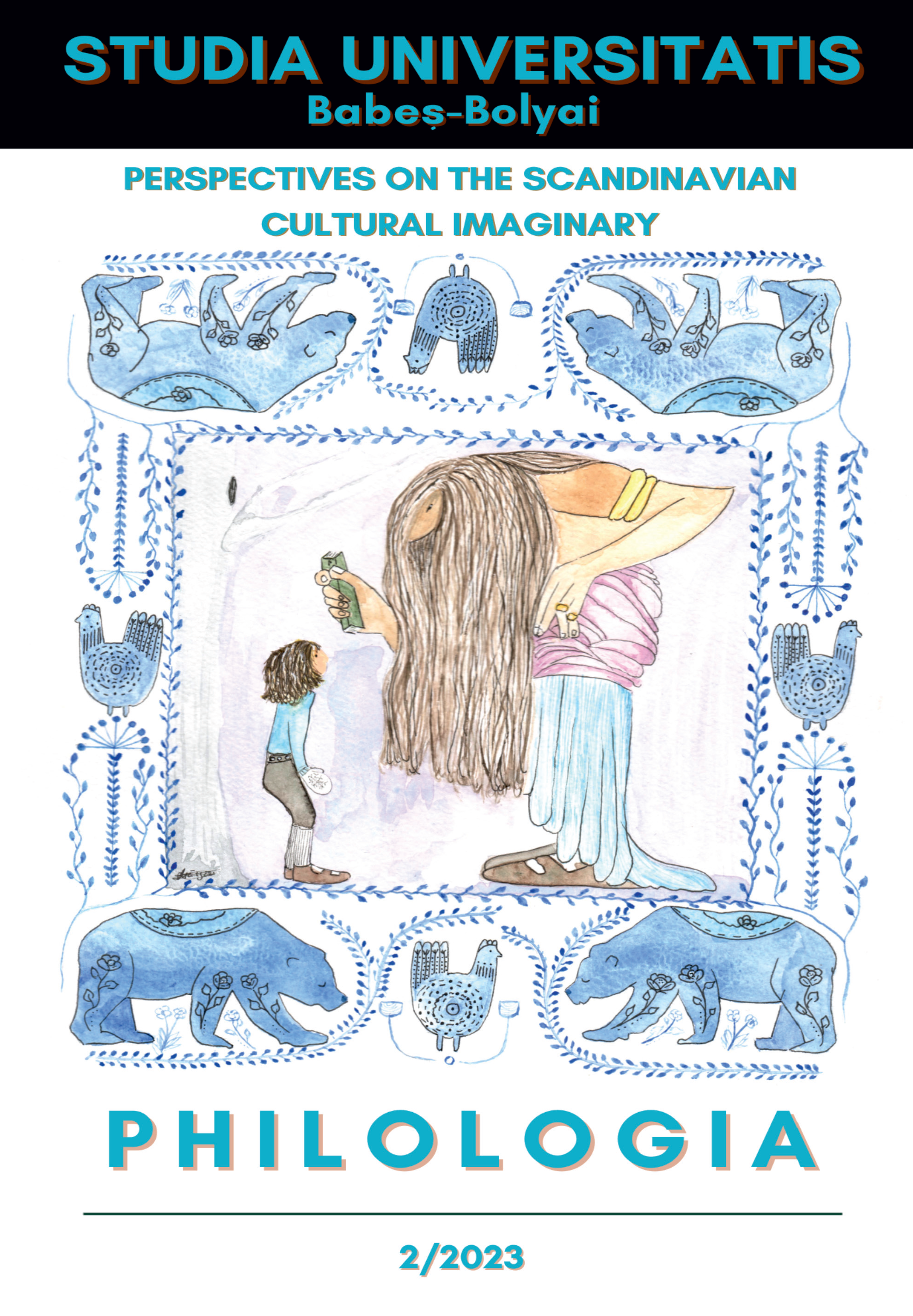REVISITING NORSE MYTHOLOGY: THE CASE OF A.S. BYATT’S "RAGNARÖK"
DOI:
https://doi.org/10.24193/subbphilo.2023.2.07Keywords:
Ragnarök, A. S. Byatt, reinterpretation, Norse myths, death of the godsAbstract
Revisiting Norse Mythology: The Case of A.S. Byatt’s Ragnarök. In 2011, British author and Booker-prize winner A. S. Byatt publishes Ragnarök, her rewriting of the Norse myth about the death of the gods. Seen through the eyes of a thin child who is forced to witness the terrors of World War II, the story and characters of the Norse myth are reinterpreted and retold in accordance with the child’s vision, imagination and feelings. The paper here focuses on the association of the Scandinavian imaginary with specific moments in A. S. Byatt’s personal history, and highlights the use of certain patterns and ideas that are present in both, trying to pinpoint the elements that make possible the transformation of the mythical into the actual. The aim of this study is to explore the evolution of the mythological events as they are rewritten in Byatt’s 21st century book, in close connection with the main character’s personal development. To that end, the paper will also dwell upon the comparison drawn by Byatt herself between the Norse and the Christian mythological imaginary – a vision filtered through the eyes and thoughts of the focalizer of the text, the thin child.
REZUMAT. Explorarea mitologiei nordice: cazul cărții Ragnarök, de A.S. Byatt. În 2011, autoarea britanică A. S. Byatt, câștigătoare a Premiului Booker, publică Ragnarök, o rescriere a mitului scandinav în care se vorbește despre moartea zeilor. Privite prin ochii unui copil slăbuț care e forțat să fie martorul ororilor celui de-al Doilea Război Mondial, povestea și personajele din mitologia nordică sunt reinterpretate și repovestite prin filtrul viziunii, imaginației și sentimentelor copilului. Articolul de față se concentrează pe asocierea imaginarului scandinav cu momente specifice din istoria personală a lui A. S. Byatt, și evidențiază anumite tipare și idei care sunt prezente în ambele cazuri, încercând să identifice acele elemente care fac posibilă transformarea miticului în real. Obiectivul acestui studiu este acela de a explora evoluția întâmplărilor mitologice așa cum sunt ele rescrise în cartea din secolul al 21-lea a lui Byatt, în strânsă legătură cu dezvoltarea personală a personajului ei principal. În acest scop, lucrarea va insista și asupra comparației făcute de Byatt însăși între imaginarul mitologic nordic și cel creștin – viziune filtrată prin ochii și gândurile focalizatorului textului, copilul cel slăbuț.
Cuvinte-cheie: Ragnarök, A. S. Byatt, reinterpretare, mituri nordice, moartea zeilor
Article history: Received 28 January 2023; Revised 26 April 2023; Accepted 30 May 2023;
Available online 23 June 2023; Available print 30 June 2023.
References
Armstrong, Karen. 2005. A Short History of Myth. Canongate Canons: Main.
Atwood, Margaret. 2005. The Penelopiad. Faber and Faber: Main.
Bal, Mieke. 1985. Narratology: Introduction to the Theory of Narrative. Toronto: Toronto University Press.
Barthes, Roland. 1970. Image Music Text. Translated by Stephen Heath. London: Fontana P, 1993.
Barthes, Roland. 1973. S/Z. Translated by Richard Miller. Blackwell Publishing Ltd, 2002.
Barthes, Roland. 1968. The Death of the Author. Translated by Richard Howard. https://web.archive.org/web/20200419132326/http://www.ubu.com/aspen/aspen5and6/threeEssays.html#barthes, accessed on April 25th, 2023.
Booth, Wayne. The Rhetoric of Fiction 1961. Chicago: University of Chicago Press.
Byatt, A. S. 2011. Ragnarök. The End of the Gods. Edinburgh: Canongate.
Byatt, A. S. 1991. Possession: A Romance. New York: Vintage.
Byatt, A. S. 1996. Babel Tower. London: Chatto & Windus.
Byatt, A. S. 2001. On Histories and Stories. London: Vintage.
Byatt, A.S. (Introduction). 2012 in Tatar, Maria (ed) The Annotated Brothers Grimm, W. W. Norton & Company.
A.S. Byatt Home Page. http://www.asbyatt.com/Onherself.aspx, accessed on September 20th 2009.
Cambridge Dictionary online. https://dictionary.cambridge.org/dictionary/english/ reinterpret, accessed on April 24th, 2023.
Cheira, Alexandra. 2020. “I Have This Kind of Grief for the Earth”: AS Byatt’s Ecopoetics in Ragnarök, “Thoughts on Myth” and “Sea Story in American, British and Canadian Studies, issue 35, Editura Universitatii LUCIAN BLAGA din Sibiu, pp. 44-67.
Călinescu, Matei. 1993. Rereading. New Haven and London: Yale University Press.
Ferguson, Robert. 2018. Scandinavians: In Search of the Soul of the North. New York: Abrams Press.
Foucault, Michel. 1977. Language, Counter-Memory, Practice. Translated by Donald F. Bouchard and Sherry Simon. Ithaca: Cornell University Press.
Freeman, M. 1998. “Mythical time, historical time and the narrative fabric of the self.” Narrative Inquiry, 8(1), 27–50.
Genette, Gerard 1980. Narrative Discourse: An Essay in Method. Ithaca: Cornell University Press.
Grossman, David. 2006. Lion’s Honey. Translated by Stuart Schoffman. Canongate
Harrison, M John. 2011. “Ragnarok: The End of the Gods by AS Byatt – review. AS Byatt reworks Norse myths with aplomb.” The Guardian, Fri 9 Sep 2011. https://www.theguardian.com/books/2011/sep/09/ragnarok-as-byatt-review, accessed on January 11th, 2023.
Kirby, W. F. 1913. “The Voluspá, The Sibyl’s Lay in the Edda of Sæmund”. Saga-Book, 8, 44–52. https://www.jstor.org/stable/48611688
McCall Smith, Alexander. 2006. Dream Angus. Vintage Canada.
Nicholson, Virginia. 2018. “The 1940s: Britain’s wartime women gained a new sense of power”. The Guardian, February 3, 2018.
Oxford Dictionary online.
https://www.oxfordlearnersdictionaries.com/definition/english/the-oxford-english-dictionary, accessed on April 24th, 2023.
Pullman, Philip. 2010. The Good Man Jesus and the Scoundrel Christ. Main – Canons Edition, 2017.
Rimmon-Kenan, Schlomith 1983, 2002. Narrative Fiction. London: Routledge.
Schjødt, Jens Peter. 2019. “The Ragnarǫk Myth in Scandinavia –Finding, Inheriting, and Borrowing”. Finding, Inheriting or Borrowing? – The Construction and Transfer of Knowledge in Antiquity and the Middle Ages, edited by Jochen lthoff, Dominik Berrens and Tanja Pomerening, 365-384.
https://doi.org/10.1515/9783839442364-015
Smith, Ali. 2007. Girl Meets Boy. Edinburgh: Canongate.
The Holy Bible. 1989. New Revised Standard Version Bible. Thomas Nelson Publishers, Nashville.
Wijianto, Agung. 2020. “Comparative Literature Study of Motif Differences in Ragnarok and the Book of Revelation”. Lire Journal (Journal of Linguistics and Literature), 4(1), 50-63. https://doi.org/10.33019/lire.v4i1.61.
Winterbourne, Anthony. 2004. When the Norns Have Spoken: Time and Fate in Germanic Paganism. Vancouver: Fairleigh Dickinson University Press.
Winterson, Jeanette. 2005. Weight. Edinburgh: Canongate Books Ltd.
Downloads
Published
How to Cite
Issue
Section
License
Copyright (c) 2023 Studia Universitatis Babeș-Bolyai Philologia

This work is licensed under a Creative Commons Attribution-NonCommercial-NoDerivatives 4.0 International License.





 ©Studia Universitatis Babeş-Bolyai Philologia. Published by Babeș-Bolyai University.
©Studia Universitatis Babeş-Bolyai Philologia. Published by Babeș-Bolyai University.